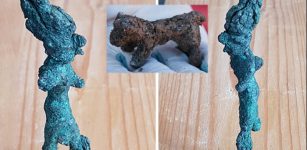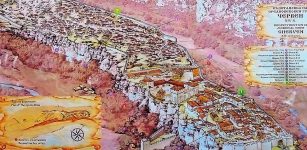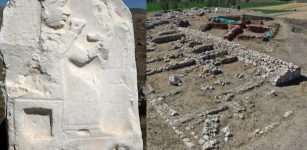Missing Piece Of A Linguistic Puzzle: Ancient DNA Identifies The Originators Of Indo-European Languages Spoken By 40% Of The World
Jan Bartek – MessageToEagle.com – Two landmark studies have successfully traced the origins of the Indo-European language family, which encompasses over 400 languages spoken by more than 40% of the global population today.
Credit: Pixabay – qimono -Public Domain
DNA evidence has pinpointed these originators to present-day Russia during the Eneolithic period, approximately 6,500 years ago. These early linguistic innovators inhabited areas ranging from the steppe grasslands along the lower Volga River to the northern foothills of the Caucasus Mountains and are referred to by researchers as the Caucasus Lower Volga people. Genetic findings indicate that they intermingled with other groups in their region.
“It’s a very early manifestation of some of the cultural traditions that later spread across the steppe,” said senior author David Reich, a professor of genetics at Harvard Medical School and human evolutionary biology in the Faculty of Arts and Sciences.
The research sheds light on a crucial element of a longstanding linguistic mystery. In the late 18th century, scholars observed similarities among the distant languages of Latin, Greek, and Sanskrit. This led to the development of the steppe hypothesis in the 19th century, which was formalized in the 1950s. It suggested that speakers of an ancestral Indo-European language resided on the Eurasian steppe. Linguistic reconstructions and archaeological findings have placed these speakers in what is now Russia and Ukraine.
“It’s the first time we have a genetic picture unifying all Indo-European languages,” said co-first author Iosif Lazaridis, research associate in human evolutionary biology in the Faculty of Arts and Sciences (FAS) at Harvard University.
In the late 18th century, scholars began to observe similarities among the distant languages of Latin, Greek, and Sanskrit. This observation laid the groundwork for the steppe hypothesis, which emerged in the 19th century and was further developed in the 1950s. This hypothesis utilized linguistic reconstructions and archaeological findings to pinpoint the geographic origins of Proto-Indo-European languages.
For over 15 years, researchers in Reich’s lab have been investigating Proto-Indo-European speakers. In 2014, they revealed significant insights into “the profound mixing event” that influenced modern Europeans, most of whom are descended from three distinct populations.
The following year, scientists from Reich’s lab provided a more comprehensive understanding of Europe’s Yamnaya ancestors. These notable nomadic pastoralists are recognized for likely being pioneers in horseback herding and possibly inventing oxen-towed wagons.
“They turned over the population of Europe with huge disruptions in Germany, Spain, Italy, and Hungary,” said Reich, professor of genetics in the Blavatnik Institute at HMS, professor of human evolutionary biology in FAS, and senior associate member of the Broad Institute of MIT and Harvard. “In Britain, there was a 90 percent-plus population replacement within decades.”
The 2015 paper credited the far-traveling Yamnaya with carrying Indo-European languages across Europe and into the Indian subcontinent. A subsequent series of papers, published by Reich’s lab and others, followed their genetic footprints into Greece, Armenia, India, and China.
“It’s like a tracer dye,” Reich said. “You can actually see Yamnaya ancestry everywhere these languages went.”
But researchers encountered a hitch in the Yamnaya line in the Anatolian peninsula, where an extinct set of Indo-European languages was spoken during the Bronze Age. Linguists have long believed they represent an early split from Proto-Indo-European. The 21st-century advent of ancient DNA science surfaced similar results.
“We know from cuneiform tablets that people such as the Hittites spoke Anatolian, but these people didn’t have Yamnaya ancestry,” Reich noted. “We looked hard, with lots of data. We didn’t find anything. So we hypothesized some deeper population was the ultimate source in Indo-European languages.”
The Caucasus Lower Volga people is that original source, the authors said.
The work uncovers new links between those people and both the Yamnaya and the ancient Indo-Anatolian speakers who inhabited an area that is now part of Turkey.
The Caucasus Lower Volga people mixed prodigiously with other groups in the region, the findings indicate.
“It’s a very early manifestation of some of the cultural traditions that later spread across the steppe,” said Reich.
The Russia-Ukraine war forced an unusual splintering of the findings. The first paper, focused on the origins of Indo-European languages, draws on the ancient DNA of 354 individuals at archaeological sites in Russia and Southeastern Europe. The second, authored with researchers in Kyiv, is based on 81 ancient DNA samples drawn from Ukraine and Moldova. Also part of the analyses are previously reported genetic data on nearly 1,000 ancient individuals.
The first paper traces various lineages from the Caucasus Lower Volga people, including the Yamnaya and the Anatolians. The second paper provides rich new context on the Yamna, the Ukrainian term for Yamnaya. It finds evidence that the culture may have taken root somewhere near the present-day small town of Mykhailivka in the southern part of Ukraine.
“Where the worst of the fighting is happening right now — that’s the Yamnaya homeland,” said co-first author David Anthony, emeritus professor of anthropology at Hartwick College in New York, former visiting scholar in the Reich Lab, and author of a 2007 book on the Yamnaya’s role in disseminating Proto-Indo-European.
The findings reveal that a population of Caucasus Lower Volga people moved west and started mixing with locals, forming the distinct Yamnaya genome.
Genetic reconstruction of the ancestry of Pontic-Caspian steppe and West Asian populations points to four key locations. Credit: Adapted from Nature (2025). DOI: 10.1038/s41586-024-08531-5
“We found that the Yamnaya descend from just a few thousand people living in a handful of neighboring villages from 5,700 to 5,300 years ago,” Reich said. “Their descendants developed a radically new economy that allowed them to follow their herds of livestock into previously inaccessible open steppe lands. This led to a demographic explosion, so that in a few hundred years Yamnaya descendants numbered many tens of thousands and were spread from Hungary to eastern China.”
The Yamnaya culture inherited more than just language from their Caucasus Lower Volga ancestors. Both groups practiced the tradition of burying their dead in kurgans, which are large tombs covered with mounds of earth. These burial sites have long been a focal point for archaeologists and have played a crucial role in allowing researchers to genetically reconstruct these ancient peoples’ origins, as Lazaridis noted.
“Suppose the Yamnaya had a different culture,” offered co-first author Nick Patterson, deputy head of the Reich Lab, an associate in FAS, and senior computational biologist at the Broad Institute. “Suppose they had cremated their dead. Chances are, we wouldn’t even know about this crucial culture in human history.”
The study was published in the journal Nature
Written by Jan Bartek – MessageToEagle.com – AncientPages.com Staff Writer












